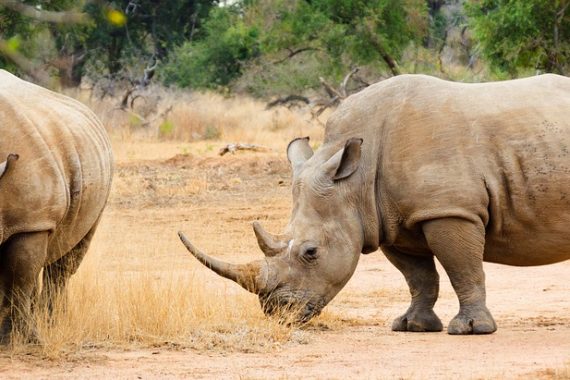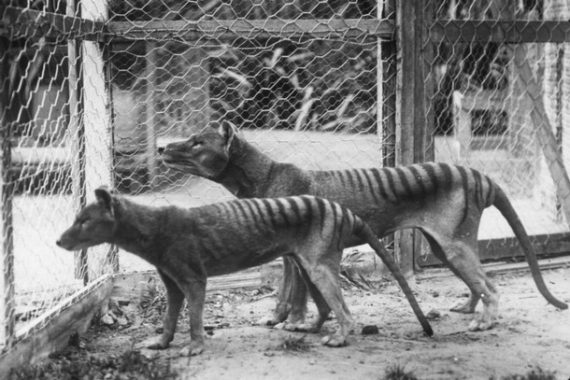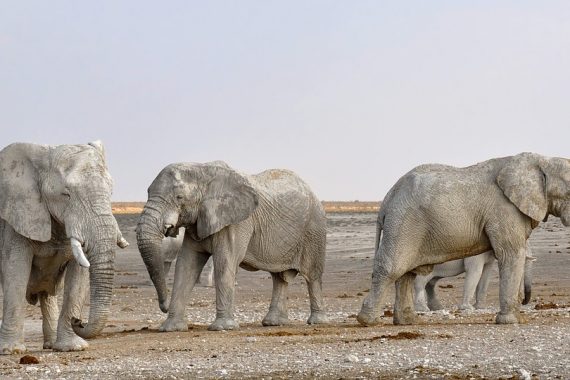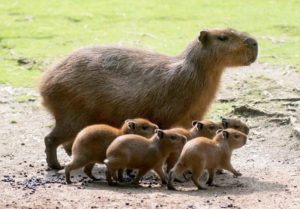
The cute capybara (image from www.zooborns.com)
When Iberian colonists first arrived to South America and saw the vast, never before seen diversity of the continent, they saw the large furry brown creatures that later became known as the capybara gathering by waterways. These early colonists thought these mammals were a type of hairy pig, which is a fairly reasonable assumption to make! Who amongst those early adventurers would have believed the capybara is actually the world’s largest rodent!
Belonging to the subfamily Hydrochoerinae, the capybara is related to guinea pigs and rock cavies, and more distantly to the agouti. Although they are emblematic of South America, the ancestors of the capybara actually evolved in Africa around 80 million years ago, and arrived to the South American content 40 million years later. When they arrived, the continent was almost devoid of predators, which is the likely reason that capybaras reached such huge sizes for a rodent. Usually, rodents are under evolutionary pressure to remain small, helping them to evade predators, but without this pressure, capybaras could reach much bigger sizes. When scientists began to dig into their genome, they discovered that capybaras have a unique form of insulin that has increased their ability to divide their cells, boosting their growth rate. Not only this, but capybaras don’t have the increased cancer risk that comes with a larger body. Their immune system is turbo charged and evolved to identify and destroy cells that are pre-cancerous, like their very own in-built immunotherapy.
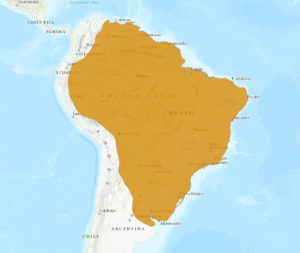
The range of the capybara (image from the IUCN red list)
Capybaras inhabit the seasonally flooded savannahs of tropical and subtropical South America, and are even known to flourish in more human dominated areas, like urban parks and cattle ranches. Escaped capybaras may even be making a home in the North of Florida and parts of the Californian coast, although it doesn’t seem like they have established a breeding population yet. Usually, we would be concerned about invasive species and the damage they can cause, but in the case of the capybara, there is fossil evidence that they once inhabited the coastal regions of Florida and California, and that today they may even fill a missing ecological niche!
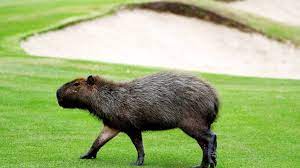
A capybara on a golf course in Florida (image from the Orlando Sentinel)
Amazing aquatic adaptations: the ecology of the capybara
Since capybaras spend most of their time around water, they have developed amazing adaptations to their semi-aquatic lifestyles. They are excellent swimmers, and often use the water as a way to escape predators, like the jaguar. They often wallow in the water and in mud during the hottest parts of the day, and forage in the cooler hours of the early morning and late evening. They can even sleep in the water, leaving just their nostrils sticking out.
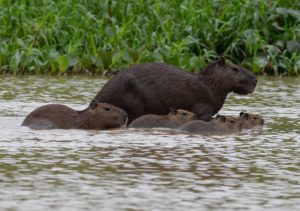
A family of capybara showcasing their amazing swimming capabilities (image from ommons.wikimedia.org)
As herbivores, much of their diet consists of tough to digest plants, and this is why capybara are auto-coprophagous; they eat their own poop! It sounds disgusting, but they are not the only animals to do this, and it is incredibly beneficial for them. Their faeces contain helpful gut bacteria that help them to digest the tough, string cellulose in their diet, helping them to get the most nutrient out of their food. Similar to cattle, they masticate, or chew the cud, after regurgitating their food. Again, this extra chewing helps them properly digest their food.
Interestingly, capybara also cannot synthesise vitamin C. In the wild, they can get this essential nutrient from their varied diet, but in captivity they must be supplemented with vitamin C tablets, or else they develop scurvy, just like humans that are deprived of vitamin C.
Capybaras are incredibly social animals, living in groups of 10 – 20 individuals including adult males and females and their young. In the dry season, when water sources begin to dry up, groups of anywhere between 50 to 100 individuals will gather together around water. They have a highly advanced sense of smell, and will communicate through scent marking
Dominant males will protect the females in their group, but as they can’t be everywhere all at once, often subordinate males will sneak in and mate with the females. Capybaras will have litters of four babies on average, who have to be mobile within a few hours to keep up the rest of the group and give them the best chance against opportunistic predators looking for an easy meal. After around 16 weeks, the litters are weaned and are practically independent, ready to swim with the rest of the herd.
An Amazon staple: the future of the capybara
Fortunately, capybaras are classed as least concern by the IUCN red list, and are well distributed throughout their range. In some areas, populations have taken a hit as they are a popular source of meat in South America, although their fast reproduction means their numbers can bounce back pretty quickly. Their meat is low in saturated fats and cholesterol, and so they are a healthy source of protein for local people. On some areas they are well protected as a food resource, and capybara farms are even being considered, provided there are some important ethical controls and the animals aren’t over hunted.
Although capybaras are currently pretty safe, there is no ignoring the major dilemmas facing the Amazon and other rainforest habitat in South America. Deforestation is one of the most pressing issues of our time, and continues to plague the continent, with 4.8 million acres of the Amazon lost in 2021 alone to increasing agriculture and human development. This loss of the rainforest is not just bad for the many plants and animals that rely on it, but also exacerbates climate change, as trees soak up anthropogenic carbon dioxide from the atmosphere. The loss of the complex network of trees and other plants has also led to increased soil erosion, which is not only threatening flora and fauna but the food security of local people too, as their crops no longer grow as efficiently in these eroded regions. Pollution is now a major issue in many freshwater rivers, which is affecting peoples access to safe drinking water in their homes, as well as putting more pressure on struggling freshwater ecosystems in the rainforest, which are often understudied and under-protected.
The Tropical Forest Alliance is a not for profit organisation that is working to protect the rainforests of South America not only for the amazing diversity of animals and plants, but also for indigenous people and communities further afield that rely on these ecosystems. They work with companies all over the world to help them reduce their reliance on products derived through mass deforestation, changing supply chains to be more sustainable. You can learn more about their work at Home » Tropical Forest Alliance.

There are some small changes you can make in your own life to help secure the future of the rainforests. You don’t have to become completely vegetarian, but cutting down on eating red meat a few days a week can help ease some of the pressure from large scale cattle ranching in the Amazon. You can check for products carrying the Forest Stewardship Council label, which is a certification system developed by the WWF indicating that the tree the product is created from is a responsibly managed tree. Cutting down on paper products will also be an enormous help to the amazon, like using your own reusable cloth bags and avoiding disposable plates and cups as much as you can. Any small steps you can make will all be part of a big change!
Amazing videos!
References
Cueto, G.R. Allekotte, R. and Kravetz, F.O. (2000) ‘Scurvy in capybaras bred in captivity in Argentina.’ Journal of Wildlife Diseases
Herrera, E.A. Salas, V. Congdon, E.R. Corriale, M.J. and Tan-Martínez, Z. (2011) ‘Capybara social structure and dispersal patterns: variations on a theme.’ Journal of Mammalogy
Lundgren, E.J. Ramp, D. Rowan, J. Middleton, O. Schowanek, O.S. Carrol, S.P. Davis, M. Sandom, C.J. Svenning, J.C. Wallach, A.D. and Estes, J.A. (2020) ‘Introduced herbivores restore late Pleistocene ecological functions.’ PNAS
Moreira, J.R. Alvarez, M.R. Tarifia, T. Pacheco, V. Taber, A. Tirira, D.G. Herrera, E.A. Ferraz, K.M.P.M.B. Aldana-Domínguez, J. and Macdonald, D.W. (2012) ‘Taxonomy, natural history and distribution of the capybara.’ Capybara
Nogueira-Filho, S.L. and da Cunha Noguiera, S.S. (2018) ‘Capybara meat: an extraordinary resource for food security in South America.’ Meat Science
MASSIVE THANK YOU TO RACHAEL DA SILVA FROM THE UK FOR THIS WRITE UP! PLEASE FOLLOW HER ON INSTAGRAM AND HER WILDLIFE ARTWORK AT TILLY_MINT08


